Drought Assessment in the São Francisco River Basin Using Satellite-Based and Ground-Based Indices
Abstract
:1. Introduction
2. Materials and Methods
2.1. Study Area
2.2. Datasets
2.2.1. Ground-Based Data
Precipitation and Potential Evapotranspiration Data
Streamflow Data
2.2.2. Satellite-Based Data
SMOS Surface Soil Moisture Data
GRACE/GRACE-FO Data
2.3. Drought Indices
2.3.1. Ground-Based Drought Indices
Standardized Precipitation Evapotranspiration Index (SPEI)
Standardized Streamflow Index (SSI)
2.3.2. Satellite-Based Drought Indices
SMOS-Based Soil Water Deficit Index (SWDIS)
Self-Calibrating Palmer Drought Severity Index (scPDSI)
Water Storage Deficit Index (WSDI)
GRACE-Based Groundwater Drought Index (GGDI)
2.4. Methodology
3. Results
3.1. Spatial–Temporal Trends of SPEI3 and SPEI12
3.2. Temporal Variations of the Area under Drought Condition Based on SPEI12 and SPEI3
3.3. Extreme Drought Events for the Period 1980–2015
3.4. Paired Intercomparison between the Drought Indices
3.5. Coupling between the Drought Indices
3.6. Recent Variations in Agriculture and Hydrological Drougths Based on scPDSI and WSDI
4. Discussion
5. Conclusions
- A moderate basin-wide drying trend at annual time scale affected the middle and south regions of the SFRB from 1980 to 2015, coinciding with the ENSO phenomenon and SST anomalies in the tropical Atlantic, as already mentioned in previous studies.
- An expansion of the area under drought conditions was observed during the winter months (i.e., JJA), but there was no evidence of a significant positive trend in the remaining seasons in terms of spatial coverage between 1980 and 2015.
- The long-term extreme drought events showed increasing trends in terms of severity and duration, but this characteristic was not observed on a seasonal time scale during 1980–2015.
- The SWDISa and WSDI showed a good performance in assessing agricultural and hydrological droughts across the whole SFRB.
- A marked depletion of groundwater levels concurrent with increase in soil moisture content was observed during the most severe drought conditions, which means an intensification of the groundwater abstraction for irrigation.
- According to the most recent data from the SWDISa and WSDI, prolonged drought conditions appear to be reversing.
Supplementary Materials
Author Contributions
Funding
Institutional Review Board Statement
Informed Consent Statement
Data Availability Statement
Acknowledgments
Conflicts of Interest
References
- Bakker, K. Water Security: Research Challenges and Opportunities. Science 2012, 337, 914–915. [Google Scholar] [CrossRef] [PubMed]
- de Assis Souza Filho, F.; Formiga-Johnsson, R.M.; de Carvalho Studart, T.M.; Abicalil, M.T. From Drought to Water Security: Brazilian Experiences and Challenges. In Global Water Security; Springer: Berlin/Heidelberg, Germany, 2018; pp. 233–265. [Google Scholar]
- Awange, J.L.; Mpelasoka, F.; Goncalves, R.M. When every drop counts: Analysis of Droughts in Brazil for the 1901–2013 period. Sci. Total Environ. 2016, 566–567, 1472–1488. [Google Scholar] [CrossRef] [PubMed] [Green Version]
- Marengo, J.A.; Torres, R.R.; Alves, L.M. Drought in Northeast Brazil—Past, present, and future. Theor. Appl. Climatol. 2017, 129, 1189–1200. [Google Scholar] [CrossRef]
- Marengo, J.A.; Chou, S.C.; Kay, G.; Alves, L.M.; Pesquero, J.F.; Soares, W.R.; Santos, D.C.; Lyra, A.A.; Sueiro, G.; Betts, R.; et al. Development of regional future climate change scenarios in South America using the Eta CPTEC/HadCM3 climate change projections: Climatology and regional analyses for the Amazon, São Francisco and the Paraná River basins. Clim. Dyn. 2012, 38, 1829–1848. [Google Scholar] [CrossRef]
- Maneta, M.P.; Torres, M.; Wallender, W.W.; Vosti, S.; Kirby, M.; Bassoi, L.H.; Rodrigues, L.N. Water demand and flows in the São Francisco River Basin (Brazil) with increased irrigation. Agric. Water Manag. 2009, 96, 1191–1200. [Google Scholar] [CrossRef] [Green Version]
- Paredes-Trejo, F.; Barbosa, H. Evaluation of the SMOS-Derived Soil Water Deficit Index as Agricultural Drought Index in Northeast of Brazil. Water 2017, 9, 377. [Google Scholar] [CrossRef]
- Buriti, C.; Barbosa, H.A.; Paredes-Trejo, F.J.; Kumar, T.V.L.; Thakur, M.K.; Rao, K.K. Un Siglo de Sequías: ¿Por qué las Políticas de Agua no Desarrollaron la Región Semiárida Brasileña? Rev. Bras. Meteorol. 2020, 35, 683–688. [Google Scholar] [CrossRef]
- Oliveira, D.H.M.C.; Lima, K.C.; Spyrides, M.H.C. Rainfall and streamflow extreme events in the São Francisco hydrographic region. Int. J. Climatol. 2021, 41, 1279–1291. [Google Scholar] [CrossRef]
- Paredes Trejo, F.; Brito-Castillo, L.; Barbosa Alves, H.; Guevara, E. Main features of large-scale oceanic-atmospheric circulation related to strongest droughts during rainy season in Brazilian São Francisco River Basin. Int. J. Climatol. 2016, 36, 4102–4117. [Google Scholar] [CrossRef]
- Sun, T.; Ferreira, V.; He, X.; Andam-Akorful, S. Water Availability of São Francisco River Basin Based on a Space-Borne Geodetic Sensor. Water 2016, 8, 213. [Google Scholar] [CrossRef]
- Jimenez, J.C.; Marengo, J.A.; Alves, L.M.; Sulca, J.C.; Takahashi, K.; Ferrett, S.; Collins, M. The role of ENSO flavours and TNA on recent droughts over Amazon forests and the Northeast Brazil region. Int. J. Climatol. 2019, 41, 3761–3780. [Google Scholar] [CrossRef]
- Santos, M.S.; Costa, V.A.F.; dos Santos Fernandes, W.; de Paes, R.P. Time-space characterization of droughts in the São Francisco river catchment using the Standard Precipitation Index and continuous wavelet transform. Rev. Bras. Recur. Hidricos 2019, 24, 1–12. [Google Scholar] [CrossRef] [Green Version]
- Giovannettone, J.; Paredes-Trejo, F.; Barbosa, H.; Santos, C.A.C.; Kumar, T.V.L. Characterization of links between hydro-climate indices and long-term precipitation in Brazil using correlation analysis. Int. J. Climatol. 2020, 40, 5527–5541. [Google Scholar] [CrossRef]
- Stolf, R.; de S Piedade, S.M.; da Silva, J.R.; da Silva, L.C.F.; Maniero, M.Â. Water transfer from São Francisco river to semiarid northeast of Brazil: Technical data, environmental impacts, survey of opinion about the amount to be transferred. Eng. Agrícola 2012, 32, 998–1010. [Google Scholar] [CrossRef] [Green Version]
- Guimarães, J.A., Jr. Reforma hidrica do Nordeste como alternativa à transposição do rio São Francisco. Cad. CEAS Rev. Crítica Humanid. 2016, 80–88. Available online: https://cadernosdoceas.ucsal.br/index.php/cadernosdoceas/article/view/135 (accessed on 15 January 2021).
- Mishra, A.K.; Singh, V.P. A review of drought concepts. J. Hydrol. 2010, 391, 202–216. [Google Scholar] [CrossRef]
- Cunha, A.P.M.A.; Zeri, M.; Deusdará Leal, K.; Costa, L.; Cuartas, L.A.; Marengo, J.A.; Tomasella, J.; Vieira, R.M.; Barbosa, A.A.; Cunningham, C.; et al. Extreme Drought Events over Brazil from 2011 to 2019. Atmosphere 2019, 10, 642. [Google Scholar] [CrossRef] [Green Version]
- Cunha, A.P.M.; Alvalá, R.C.; Nobre, C.A.; Carvalho, M.A. Monitoring vegetative drought dynamics in the Brazilian semiarid region. Agric. For. Meteorol. 2015, 214–215, 494–505. [Google Scholar] [CrossRef]
- Van Loon, A.F.; Laaha, G. Hydrological drought severity explained by climate and catchment characteristics. J. Hydrol. 2015, 526, 3–14. [Google Scholar] [CrossRef] [Green Version]
- Mehran, A.; Mazdiyasni, O.; AghaKouchak, A. A hybrid framework for assessing socioeconomic drought: Linking climate variability, local resilience, and demand. J. Geophys. Res. Atmos. 2015, 120, 7520–7533. [Google Scholar] [CrossRef]
- Zargar, A.; Sadiq, R.; Naser, B.; Khan, F.I. A review of drought indices. Environ. Rev. 2011, 19, 333–349. [Google Scholar] [CrossRef]
- Sheffield, J.; Wood, E.F. Drought; Earthscan: London, UK, 2012; ISBN 9781849775250. [Google Scholar]
- Park, S.-Y.; Sur, C.; Kim, J.-S.; Lee, J.-H. Evaluation of multi-sensor satellite data for monitoring different drought impacts. Stoch. Environ. Res. Risk Assess. 2018, 32, 2551–2563. [Google Scholar] [CrossRef]
- Sur, C.; Hur, J.; Kim, K.; Choi, W.; Choi, M. An evaluation of satellite-based drought indices on a regional scale. Int. J. Remote Sens. 2015, 36, 5593–5612. [Google Scholar] [CrossRef]
- Mu, Q.; Zhao, M.; Kimball, J.S.; McDowell, N.G.; Running, S.W. A Remotely Sensed Global Terrestrial Drought Severity Index. Bull. Am. Meteorol. Soc. 2013, 94, 83–98. [Google Scholar] [CrossRef] [Green Version]
- Jafari, S.M.; Nikoo, M.R.; Dehghani, M.; Alijanian, M. Evaluation of two satellite-based products against ground-based observation for drought analysis in the southern part of Iran. Nat. Hazards 2020, 102, 1249–1267. [Google Scholar] [CrossRef]
- Shahzaman, M.; Zhu, W.; Ullah, I.; Mustafa, F.; Bilal, M.; Ishfaq, S.; Nisar, S.; Arshad, M.; Iqbal, R.; Aslam, R.W. Comparison of Multi-Year Reanalysis, Models, and Satellite Remote Sensing Products for Agricultural Drought Monitoring over South Asian Countries. Remote Sens. 2021, 13, 3294. [Google Scholar] [CrossRef]
- Santos, C.A.G.; Brasil Neto, R.M.; Passos, J.S.d.A.; da Silva, R.M. Drought assessment using a TRMM-derived standardized precipitation index for the upper São Francisco River basin, Brazil. Environ. Monit. Assess. 2017, 189, 250. [Google Scholar] [CrossRef] [PubMed]
- Vicente-Serrano, S.M.; Beguería, S.; López-Moreno, J.I. A Multiscalar Drought Index Sensitive to Global Warming: The Standardized Precipitation Evapotranspiration Index. J. Clim. 2010, 23, 1696–1718. [Google Scholar] [CrossRef] [Green Version]
- Martínez-Fernández, J.; González-Zamora, A.; Sánchez, N.; Gumuzzio, A.; Herrero-Jiménez, C.M. Satellite soil moisture for agricultural drought monitoring: Assessment of the SMOS derived Soil Water Deficit Index. Remote Sens. Environ. 2016, 177, 277–286. [Google Scholar] [CrossRef]
- Wells, N.; Goddard, S.; Hayes, M.J. A Self-Calibrating Palmer Drought Severity Index. J. Clim. 2004, 17, 2335–2351. [Google Scholar] [CrossRef]
- Vicente-Serrano, S.M.; López-Moreno, J.I.; Begueria, S.; Lorenzo-Lacruz, J.; Azorin-Molina, C.; Morán-Tejeda, E. Accurate computation of a streamflow drought index. J. Hydrol. Eng. 2012, 17, 318–332. [Google Scholar] [CrossRef] [Green Version]
- Thomas, A.C.; Reager, J.T.; Famiglietti, J.S.; Rodell, M. A GRACE-based water storage deficit approach for hydrological drought characterization. Geophys. Res. Lett. 2014, 41, 1537–1545. [Google Scholar] [CrossRef] [Green Version]
- Thomas, B.F.; Famiglietti, J.S.; Landerer, F.W.; Wiese, D.N.; Molotch, N.P.; Argus, D.F. GRACE Groundwater Drought Index: Evaluation of California Central Valley groundwater drought. Remote Sens. Environ. 2017, 198, 384–392. [Google Scholar] [CrossRef]
- Beguería, S.; Vicente-Serrano, S.M.; Reig, F.; Latorre, B. Standardized precipitation evapotranspiration index (SPEI) revisited: Parameter fitting, evapotranspiration models, tools, datasets and drought monitoring. Int. J. Climatol. 2014, 34, 3001–3023. [Google Scholar] [CrossRef] [Green Version]
- Stagge, J.H.; Tallaksen, L.M.; Gudmundsson, L.; Van Loon, A.F.; Stahl, K. Candidate Distributions for Climatological Drought Indices (SPI and SPEI). Int. J. Climatol. 2015, 35, 4027–4040. [Google Scholar] [CrossRef]
- Martinez-Fernández, J.; González-Zamora, A.; Sánchez, N.; Gumuzzio, A. A soil water based index as a suitable agricultural drought indicator. J. Hydrol. 2015, 522, 265–273. [Google Scholar] [CrossRef]
- Scaini, A.; Sánchez, N.; Vicente-Serrano, S.M.; Martínez-Fernández, J. SMOS-derived soil moisture anomalies and drought indices: A comparative analysis using in situ measurements. Hydrol. Process. 2015, 29, 373–383. [Google Scholar] [CrossRef]
- Modarres, R. Streamflow drought time series forecasting. Stoch. Environ. Res. Risk Assess. 2007, 21, 223–233. [Google Scholar] [CrossRef]
- Telesca, L.; Lovallo, M.; Lopez-Moreno, I.; Vicente-Serrano, S. Investigation of scaling properties in monthly streamflow and Standardized Streamflow Index (SSI) time series in the Ebro basin (Spain). Phys. A Stat. Mech. Its Appl. 2012, 391, 1662–1678. [Google Scholar] [CrossRef]
- Nigatu, Z.M.; Fan, D.; You, W.; Melesse, A.M. Hydroclimatic Extremes Evaluation Using GRACE/GRACE-FO and Multidecadal Climatic Variables over the Nile River Basin. Remote Sens. 2021, 13, 651. [Google Scholar] [CrossRef]
- Almagro, A.; Oliveira, P.T.S.; Meira Neto, A.A.; Roy, T.; Troch, P. CABra: A novel large-sample dataset for Brazilian catchments. Hydrol. Earth Syst. Sci. Discuss. 2020, 2020, 1–40. [Google Scholar]
- Torres, M.d.O.; Vosti, S.A.; Maneta, M.P.; Wallender, W.W.; Rodrigues, L.N.; Bassoi, L.H.; Young, J.A. Spatial patterns of rural poverty: An exploratory analysis in the São Francisco River Basin, Brazil. Nov. Econ. 2011, 21, 45–66. [Google Scholar] [CrossRef]
- de Jong, P.; Tanajura, C.A.S.; Sánchez, A.S.; Dargaville, R.; Kiperstok, A.; Torres, E.A. Hydroelectric production from Brazil’s São Francisco River could cease due to climate change and inter-annual variability. Sci. Total Environ. 2018, 634, 1540–1553. [Google Scholar] [CrossRef] [PubMed]
- Beck, H.E.; Zimmermann, N.E.; McVicar, T.R.; Vergopolan, N.; Berg, A.; Wood, E.F. Present and future Köppen-Geiger climate classification maps at 1-km resolution. Sci. Data 2018, 5, 180214. [Google Scholar] [CrossRef] [Green Version]
- Braga, B.P.F.; Lotufo, J.G. Integrated River Basin Plan in Practice: The São Francisco River Basin. Int. J. Water Resour. Dev. 2008, 24, 37–60. [Google Scholar] [CrossRef]
- Marengo, J.A.; Alves, L.M.; Alvala, R.C.; Cunha, A.P.; Brito, S.; Moraes, O.L.L. Climatic characteristics of the 2010–2016 drought in the semiarid Northeast Brazil region. An. Acad. Bras. Cienc. 2018, 90, 1973–1985. [Google Scholar] [CrossRef]
- Liu, X.; Yu, L.; Si, Y.; Zhang, C.; Lu, H.; Yu, C.; Gong, P. Identifying patterns and hotspots of global land cover transitions using the ESA CCI Land Cover dataset. Remote Sens. Lett. 2018, 9, 972–981. [Google Scholar] [CrossRef]
- Ferrarini, A.d.S.F.; Ferreira Filho, J.B.d.S.; Cuadra, S.V.; Victoria, D.d.C. Water demand prospects for irrigation in the São Francisco River: Brazilian public policy. Water Policy 2020, 22, 449–467. [Google Scholar] [CrossRef] [Green Version]
- Berry, P.A.M.; Garlick, J.D.; Smith, R.G. Near-global validation of the SRTM DEM using satellite radar altimetry. Remote Sens. Environ. 2007, 106, 17–27. [Google Scholar] [CrossRef]
- Xavier, A.C.; King, C.W.; Scanlon, B.R. Daily gridded meteorological variables in Brazil (1980–2013). Int. J. Climatol. 2016, 36, 2644–2659. [Google Scholar] [CrossRef] [Green Version]
- Allen, R.G.; Pereira, L.S.; Raes, D.; Smith, M. Crop Evapotranspiration-Guidelines for Computing Crop Water Requirements; FAO Irrigation and Drainage Paper 56; FAO: Rome, Italy, 1998. [Google Scholar]
- Xavier, A.C. An update of Xavier, King and Scanlon (2016) daily precipitation gridded data set for the Brazil. In Proceedings of the 18th Brazilian Symposium on Remote Sensing, Santos, São Paulo, Brazil, 28–31 May 2017; pp. 28–33. [Google Scholar]
- Ryan, K.F.; Giles, D.E.A. Testing for Unit Roots with Missing Observations; Econometrics Working Papers 9802; University of Victoria: Victoria, BC, Canada, 1998. [Google Scholar]
- Moritz, S.; Bartz-Beielstein, T. imputeTS: Time series missing value imputation in R. R J. 2017, 9, 207–218. [Google Scholar] [CrossRef] [Green Version]
- Kerr, Y.H.; Al-Yaari, A.; Rodriguez-Fernandez, N.; Parrens, M.; Molero, B.; Leroux, D.; Bircher, S.; Mahmoodi, A.; Mialon, A.; Richaume, P.; et al. Overview of SMOS performance in terms of global soil moisture monitoring after six years in operation. Remote Sens. Environ. 2016, 180, 40–63. [Google Scholar] [CrossRef]
- González-Zamora, Á.; Sánchez, N.; Martínez-Fernández, J.; Gumuzzio, Á.; Piles, M.; Olmedo, E. Long-term SMOS soil moisture products: A comprehensive evaluation across scales and methods in the Duero Basin (Spain). Phys. Chem. Earth Parts A/B/C 2015, 83–84, 123–136. [Google Scholar] [CrossRef]
- Spatafora, L.R.; Vall-llossera, M.; Camps, A.; Chaparro, D.; Alvalá, R.C.d.S.; Barbosa, H. Validation of SMOS L3 AND L4 Soil Moisture Products In The Remedhus (SPAIN) AND CEMADEN (BRAZIL) Networks. Rev. Bras. Geogr. Física 2020, 13, 691. [Google Scholar] [CrossRef]
- Kornfeld, R.P.; Arnold, B.W.; Gross, M.A.; Dahya, N.T.; Klipstein, W.M.; Gath, P.F.; Bettadpur, S. GRACE-FO: The Gravity Recovery and Climate Experiment Follow-On Mission. J. Spacecr. Rockets 2019, 56, 931–951. [Google Scholar] [CrossRef]
- Tapley, B.D.; Bettadpur, S.; Watkins, M.; Reigber, C. The gravity recovery and climate experiment: Mission overview and early results. Geophys. Res. Lett. 2004, 31. [Google Scholar] [CrossRef] [Green Version]
- Save, H.; Bettadpur, S.; Tapley, B.D. High-resolution CSR GRACE RL05 mascons. J. Geophys. Res. Solid Earth 2016, 121, 7547–7569. [Google Scholar] [CrossRef]
- Boergens, E.; Dobslaw, H.; Dill, R.; Thomas, M.; Dahle, C.; Murböck, M.; Flechtner, F. Modelling spatial covariances for terrestrial water storage variations verified with synthetic GRACE-FO data. GEM—Int. J. Geomath. 2020, 11, 24. [Google Scholar] [CrossRef]
- Watkins, M.M.; Wiese, D.N.; Yuan, D.-N.; Boening, C.; Landerer, F.W. Improved methods for observing Earth’s time variable mass distribution with GRACE using spherical cap mascons. J. Geophys. Res. Solid Earth 2015, 120, 2648–2671. [Google Scholar] [CrossRef]
- Sakumura, C.; Bettadpur, S.; Bruinsma, S. Ensemble prediction and intercomparison analysis of GRACE time-variable gravity field models. Geophys. Res. Lett. 2014, 41, 1389–1397. [Google Scholar] [CrossRef]
- Getirana, A. Extreme Water Deficit in Brazil Detected from Space. J. Hydrometeorol. 2016, 17, 591–599. [Google Scholar] [CrossRef]
- Melo, D.C.D.; Xavier, A.C.; Bianchi, T.; Oliveira, P.T.S.; Scanlon, B.R.; Lucas, M.C.; Wendland, E. Performance evaluation of rainfall estimates by TRMM Multi-satellite Precipitation Analysis 3B42V6 and V7 over Brazil. J. Geophys. Res. Atmos. 2015, 120, 9426–9436. [Google Scholar] [CrossRef] [Green Version]
- Gadelha, A.N.; Coelho, V.H.R.; Xavier, A.C.; Barbosa, L.R.; Melo, D.C.D.; Xuan, Y.; Huffman, G.J.; Petersen, W.A.; Almeida, C. das N. Grid box-level evaluation of IMERG over Brazil at various space and time scales. Atmos. Res. 2019, 218, 231–244. [Google Scholar] [CrossRef] [Green Version]
- Lima, C.H.R.; AghaKouchak, A. Droughts in Amazonia: Spatiotemporal Variability, Teleconnections, and Seasonal Predictions. Water Resour. Res. 2017, 53, 10824–10840. [Google Scholar] [CrossRef] [Green Version]
- Bai, X.; Shen, W.; Wu, X.; Wang, P. Applicability of long-term satellite-based precipitation products for drought indices considering global warming. J. Environ. Manag. 2020, 255, 109846. [Google Scholar] [CrossRef]
- Junqueira, R.; Viola, M.R.; de Mello, C.R.; Vieira-Filho, M.; Alves, M.V.G.; Amorim, J. da S. Drought severity indexes for the Tocantins River Basin, Brazil. Theor. Appl. Climatol. 2020, 141, 465–481. [Google Scholar] [CrossRef]
- Tijdeman, E.; Stahl, K.; Tallaksen, L.M. Drought Characteristics Derived Based on the Standardized Streamflow Index: A Large Sample Comparison for Parametric and Nonparametric Methods. Water Resour. Res. 2020, 56, e2019WR026315. [Google Scholar] [CrossRef]
- Hunt, E.D.; Hubbard, K.G.; Wilhite, D.A.; Arkebauer, T.J.; Dutcher, A.L. The development and evaluation of a soil moisture index. Int. J. Climatol. 2009, 29, 747–759. [Google Scholar] [CrossRef]
- van der Schrier, G.; Barichivich, J.; Briffa, K.R.; Jones, P.D. A scPDSI-based global data set of dry and wet spells for 1901–2009. J. Geophys. Res. Atmos. 2013, 118, 4025–4048. [Google Scholar] [CrossRef]
- Hu, K.; Awange, J.L.; Khandu; Forootan, E.; Goncalves, R.M.; Fleming, K. Hydrogeological characterisation of groundwater over Brazil using remotely sensed and model products. Sci. Total Environ. 2017, 599–600, 372–386. [Google Scholar] [CrossRef] [Green Version]
- Wang, F.; Wang, Z.; Yang, H.; Di, D.; Zhao, Y.; Liang, Q. Utilizing GRACE-based groundwater drought index for drought characterization and teleconnection factors analysis in the North China Plain. J. Hydrol. 2020, 585, 124849. [Google Scholar] [CrossRef]
- Rodell, M.; Houser, P.R.; Jambor, U.; Gottschalck, J.; Mitchell, K.; Meng, C.-J.; Arsenault, K.; Cosgrove, B.; Radakovich, J.; Bosilovich, M.; et al. The Global Land Data Assimilation System. Bull. Am. Meteorol. Soc. 2004, 85, 381–394. [Google Scholar] [CrossRef] [Green Version]
- Abatzoglou, J.T.; Dobrowski, S.Z.; Parks, S.A.; Hegewisch, K.C. TerraClimate, a high-resolution global dataset of monthly climate and climatic water balance from 1958–2015. Sci. Data 2018, 5, 170191. [Google Scholar] [CrossRef] [PubMed] [Green Version]
- Hu, Z.; Liu, S.; Zhong, G.; Lin, H.; Zhou, Z. Modified Mann-Kendall trend test for hydrological time series under the scaling hypothesis and its application. Hydrol. Sci. J. 2020, 65, 2419–2438. [Google Scholar] [CrossRef]
- Yue, S.; Wang, C. The Mann-Kendall Test Modified by Effective Sample Size to Detect Trend in Serially Correlated Hydrological Series. Water Resour. Manag. 2004, 18, 201–218. [Google Scholar] [CrossRef]
- Theil, H. A Rank-Invariant Method of Linear and Polynomial Regression Analysis. In Henri Theil’s Contributions to Economics and Econometrics; Springer: Berlin/Heidelberg, Germany, 1992; pp. 345–381. [Google Scholar]
- McKee, T.B.; Doesken, N.J.; Kleist, J. The relationship of drought frequency and duration to time scales. In Proceedings of the 8th Conference on Applied Climatology, Anaheim, CA, USA, 17–22 January 1993; Volume 17, pp. 179–183. [Google Scholar]
- Junqueira, R.; Viola, M.R.; Amorim, J.S.; Mello, C.R. Hydrological Response to Drought Occurrences in a Brazilian Savanna Basin. Resources 2020, 9, 123. [Google Scholar] [CrossRef]
- Paredes-Trejo, F.; Barbosa, H.A.; Giovannettone, J.; Lakshmi Kumar, T.V.; Thakur, M.K.; de Oliveira Buriti, C. Long-Term Spatiotemporal Variation of Droughts in the Amazon River Basin. Water 2021, 13, 351. [Google Scholar] [CrossRef]
- Podobnik, B.; Stanley, H.E. Detrended Cross-Correlation Analysis: A New Method for Analyzing Two Nonstationary Time Series. Phys. Rev. Lett. 2008, 100, 084102. [Google Scholar] [CrossRef] [Green Version]
- Yue, S.; Pilon, P.; Cavadias, G. Power of the Mann–Kendall and Spearman’s rho tests for detecting monotonic trends in hydrological series. J. Hydrol. 2002, 259, 254–271. [Google Scholar] [CrossRef]
- Wu, H.; Zou, Y.; Alves, L.M.; Macau, E.E.N.; Sampaio, G.; Marengo, J.A. Uncovering episodic influence of oceans on extreme drought events in Northeast Brazil by ordinal partition network approaches. Chaos Interdiscip. J. Nonlinear Sci. 2020, 30, 053104. [Google Scholar] [CrossRef]
- Labat, D.; Ronchail, J.; Callede, J.; Guyot, J.L.; De Oliveira, E.; Guimarães, W. Wavelet analysis of Amazon hydrological regime variability. Geophys. Res. Lett. 2004, 31, 3–6. [Google Scholar] [CrossRef] [Green Version]
- Torrence, C.; Compo, G.P. A Practical Guide to Wavelet Analysis. Bull. Am. Meteorol. Soc. 1998, 79, 61–78. [Google Scholar] [CrossRef] [Green Version]
- Grinsted, A.; Moore, J.C.; Jevrejeva, S. Application of the cross wavelet transform and wavelet coherence to geophysical time series. Nonlinear Process. Geophys. 2004, 11, 561–566. [Google Scholar] [CrossRef]
- Gouhier, T.C.; Grinsted, A.; Simko, V.; Gouhier, M.T.C.; Rcpp, L. R Package Biwavelet: Conduct Univariate and Bivariate Wavelet Analyses (Version 0.20.21). 2019. Available online: https://cran.r-project.org/web/packages/biwavelet/ (accessed on 15 January 2021).
- Joshi, N.; Gupta, D.; Suryavanshi, S.; Adamowski, J.; Madramootoo, C.A. Analysis of trends and dominant periodicities in drought variables in India: A wavelet transform based approach. Atmos. Res. 2016, 182, 200–220. [Google Scholar] [CrossRef]
- Kayano, M.T.; Andreoli, R. V Relations of South American summer rainfall interannual variations with the Pacific Decadal Oscillation. Int. J. Climatol. 2007, 27, 531–540. [Google Scholar] [CrossRef]
- Kayano, M.T.; Capistrano, V.B. How the Atlantic multidecadal oscillation (AMO) modifies the ENSO influence on the South American rainfall. Int. J. Climatol. 2014, 34, 162–178. [Google Scholar] [CrossRef]
- Van Loon, A.F. Hydrological drought explained. Wiley Interdiscip. Rev. Water 2015, 2, 359–392. [Google Scholar] [CrossRef]
- Peters, E.; van Lanen, H.A.J.; Torfs, P.; Bier, G. Drought in groundwater—Drought distribution and performance indicators. J. Hydrol. 2005, 306, 302–317. [Google Scholar] [CrossRef]
- Kayano, M.T. Decadal variability of northern northeast Brazil rainfall and its relation to tropical sea surface temperature and global sea level pressure anomalies. J. Geophys. Res. 2004, 109, C11011. [Google Scholar] [CrossRef] [Green Version]
- IPCC; Masson-Delmotte, V.; Zhai, P.; Pirani, A.; Connors, S.L.; Péan, C.; Berger, S.; Caud, N.; Chen, Y.; Goldfarb, L.; et al. Climate Change 2021: The Physical Science Basis. Contribution of Working Group I to the Sixth Assessment Report of the Intergovernmental Panel on Climate Change. 2021. Available online: https://www.ipcc.ch/report/ar6/wg1/ (accessed on 10 August 2021).
- Pereira, V.; Gris, D.; Marangoni, T.; Frigo, J.; Azevedo, K.; Grzesiuck, A. Exigências agroclimáticas para a cultura do feijão (Phaseolus vulgaris L.). Rev. Bras. Energias Renov. 2014, 3, 32–42. [Google Scholar] [CrossRef]
- Penna, A.C.; Torres, R.R.; Garcia, S.R.; Marengo, J.A. Moisture flows on Southeast Brazil: Present and future climate. Int. J. Climatol. 2021, 41, E935–E951. [Google Scholar] [CrossRef]
- Marengo, J.A.; Bernasconi, M. Regional differences in aridity/drought conditions over Northeast Brazil: Present state and future projections. Clim. Chang. 2015, 129, 103–115. [Google Scholar] [CrossRef]
- Kuwajima, J.I.; Fan, F.M.; Schwanenberg, D.; Assis Dos Reis, A.; Niemann, A.; Mauad, F.F. Climate change, water-related disasters, flood control and rainfall forecasting: A case study of the São Francisco River, Brazil. Geol. Soc. Lond. Spec. Publ. 2019, 488, 259–276. [Google Scholar] [CrossRef]
- Gonçalves, R.D.; Stollberg, R.; Weiss, H.; Chang, H.K. Using GRACE to quantify the depletion of terrestrial water storage in Northeastern Brazil: The Urucuia Aquifer System. Sci. Total Environ. 2020, 705, 135845. [Google Scholar] [CrossRef]
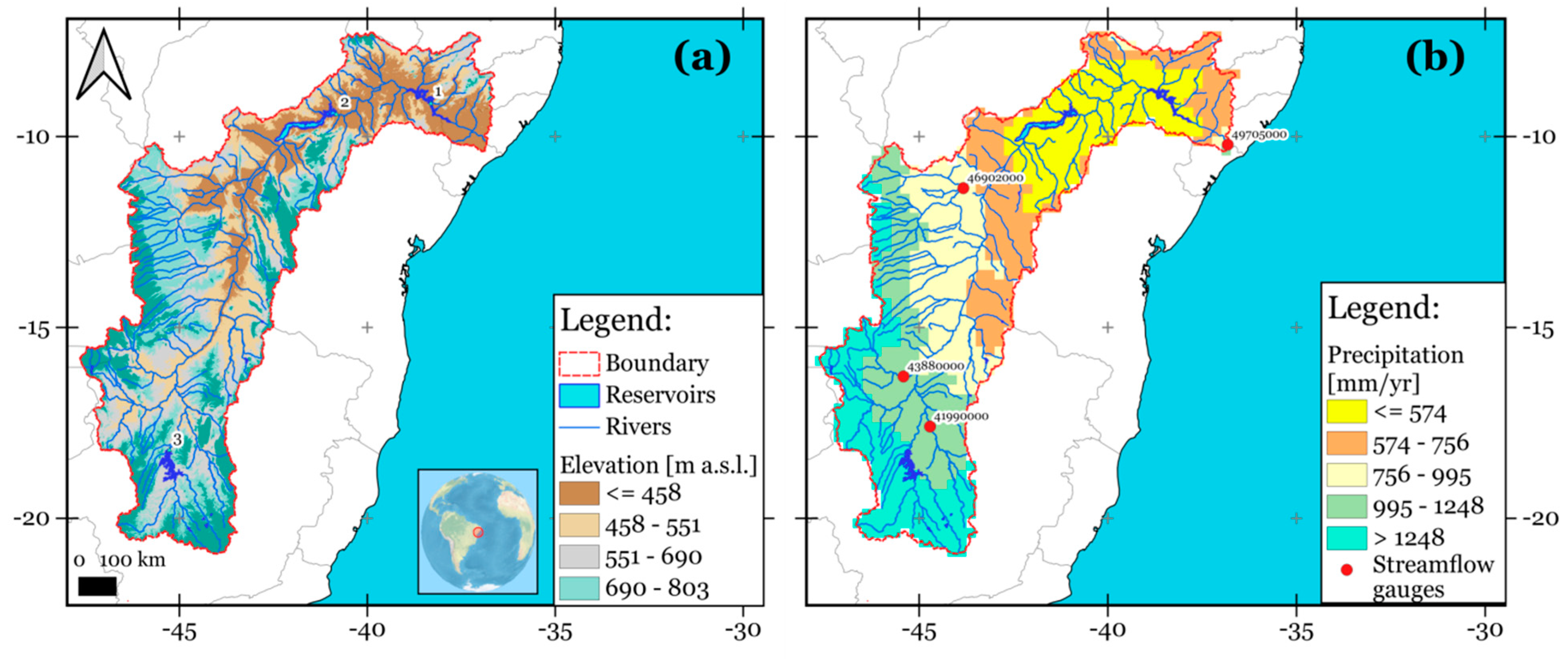


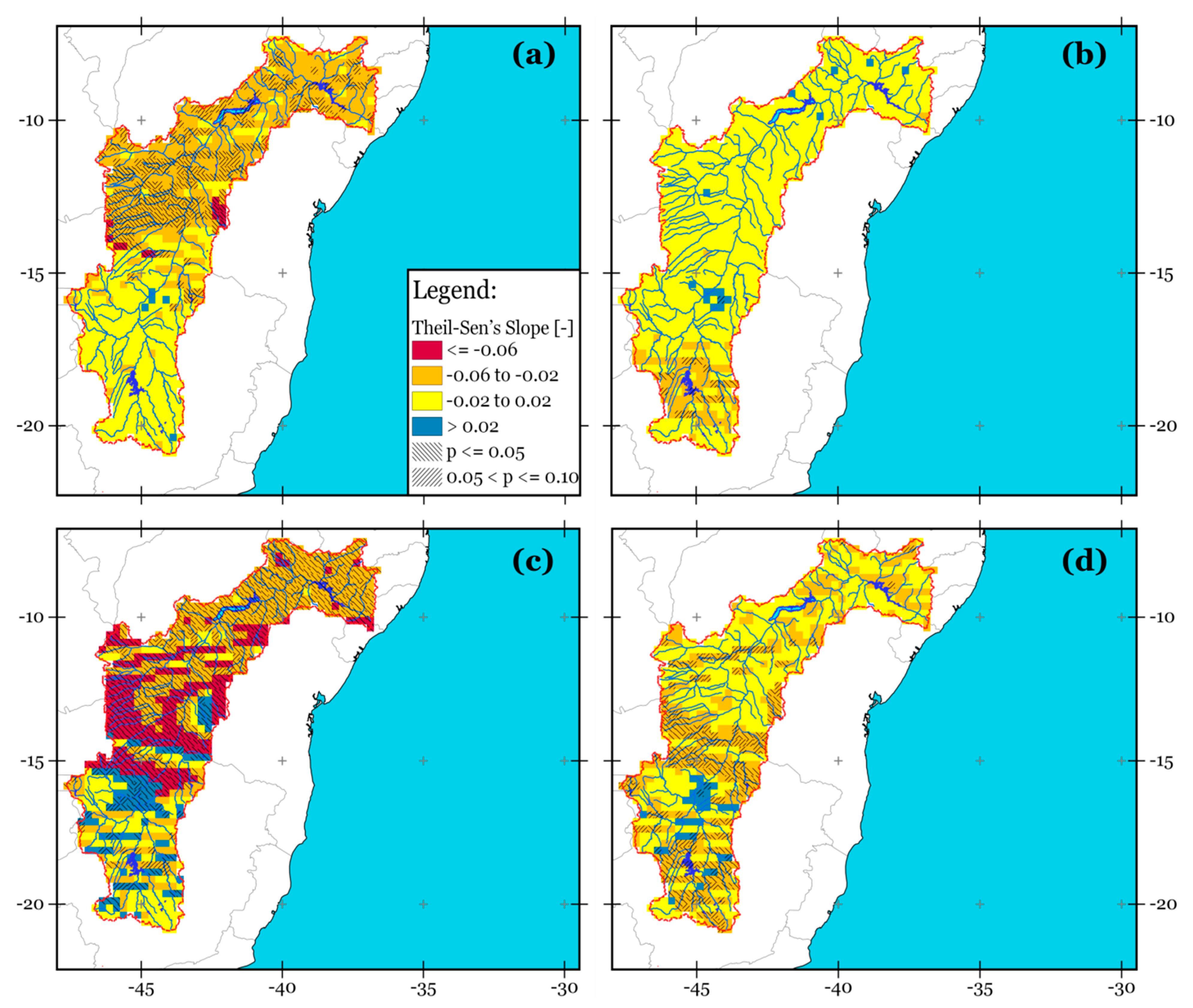

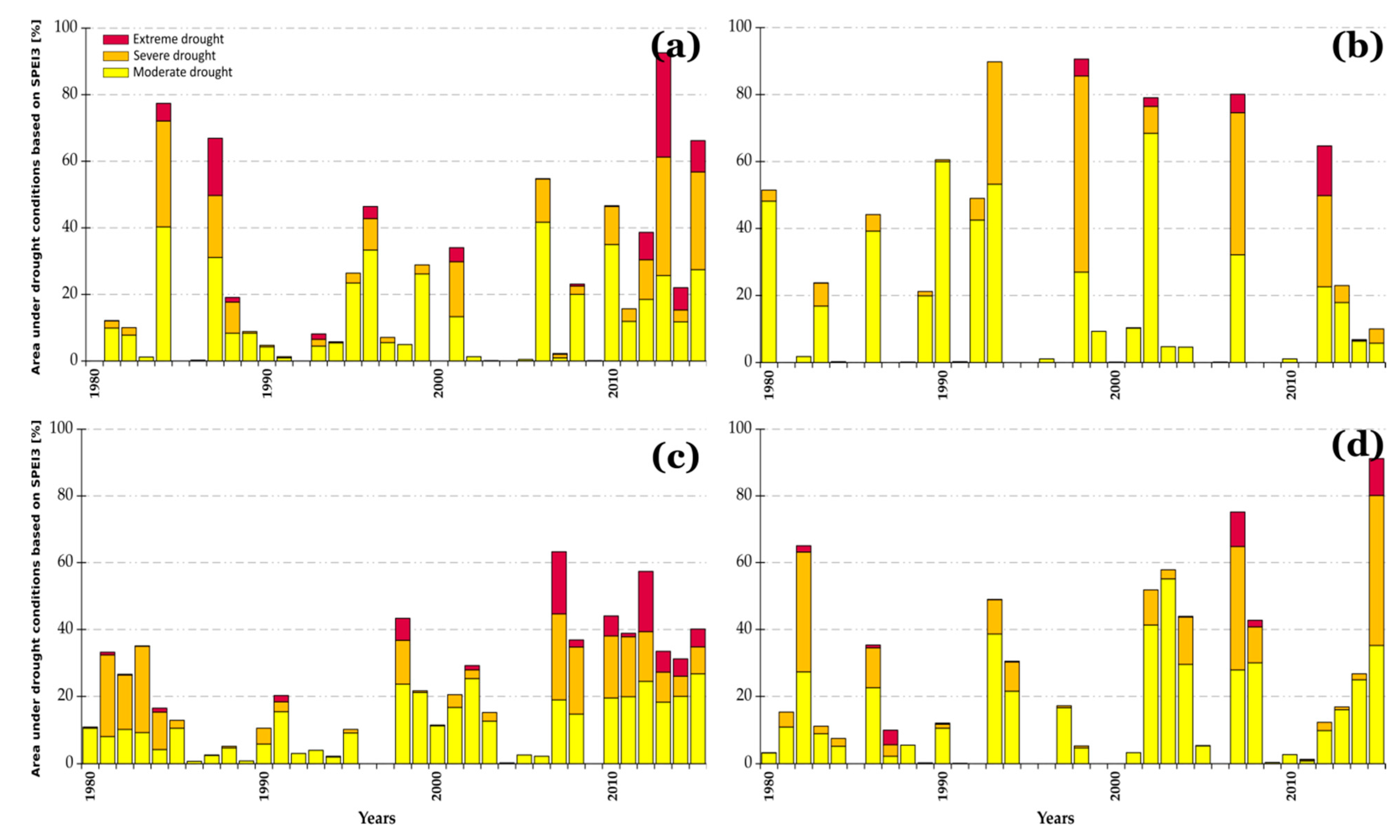
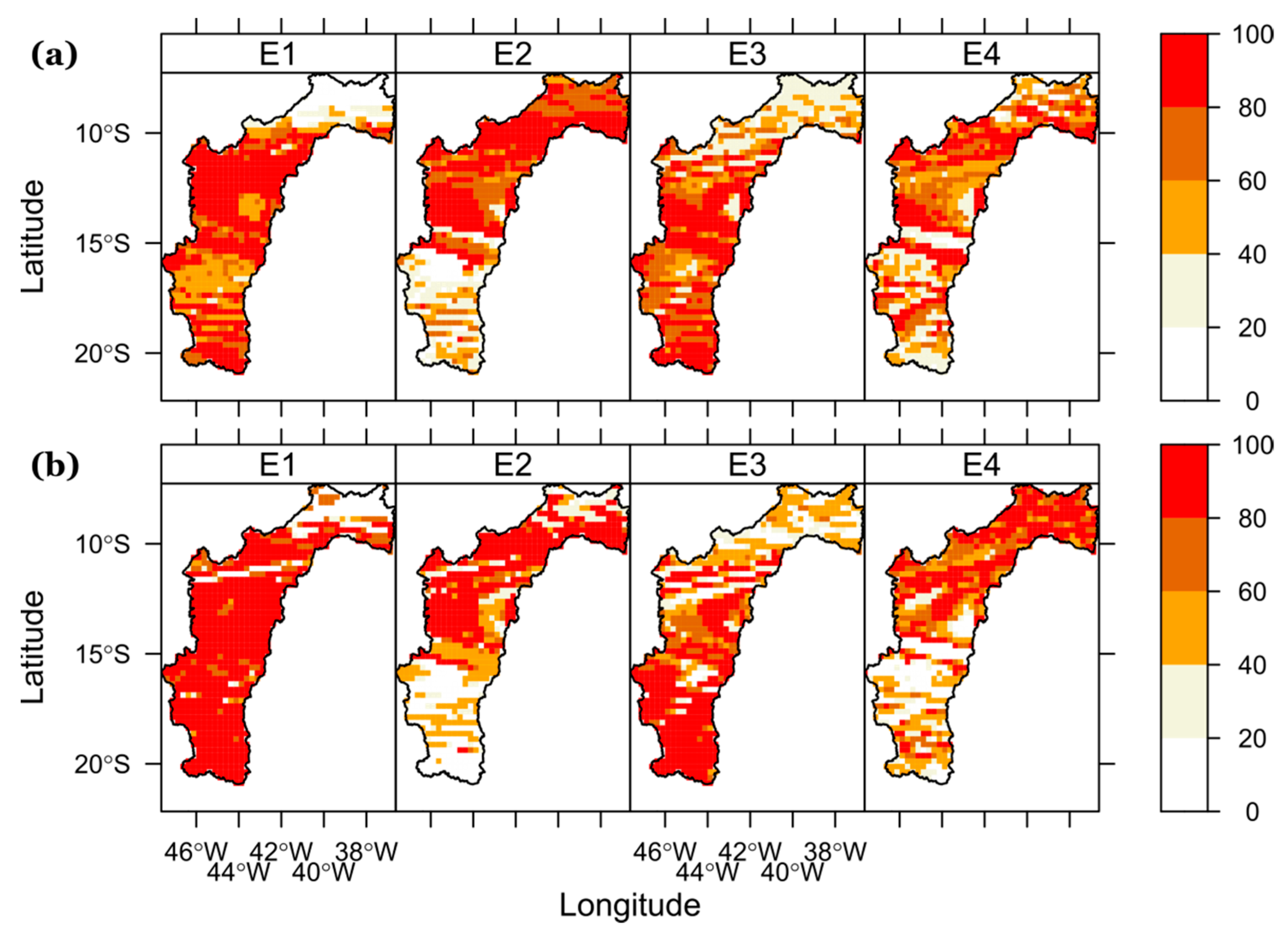
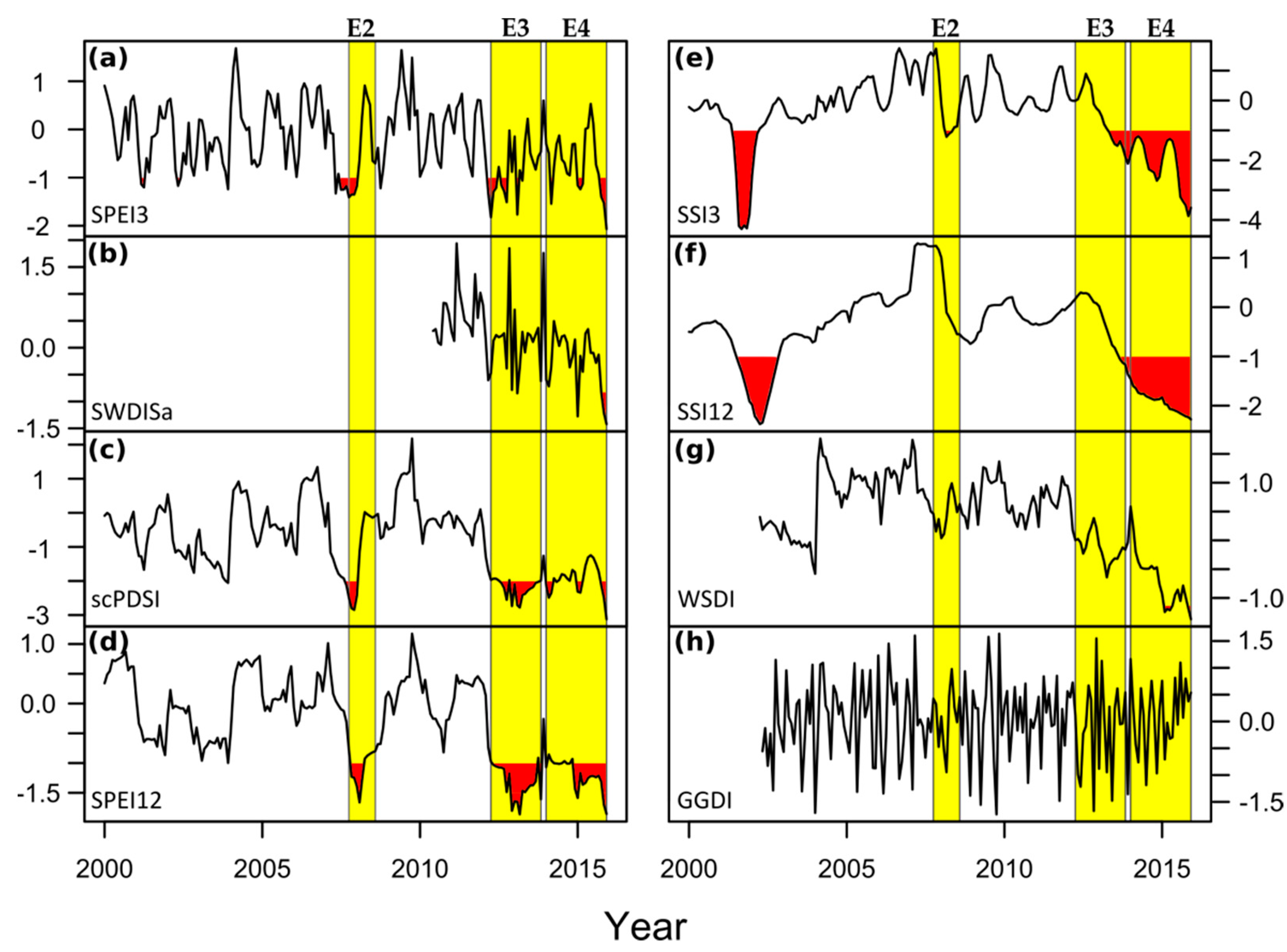

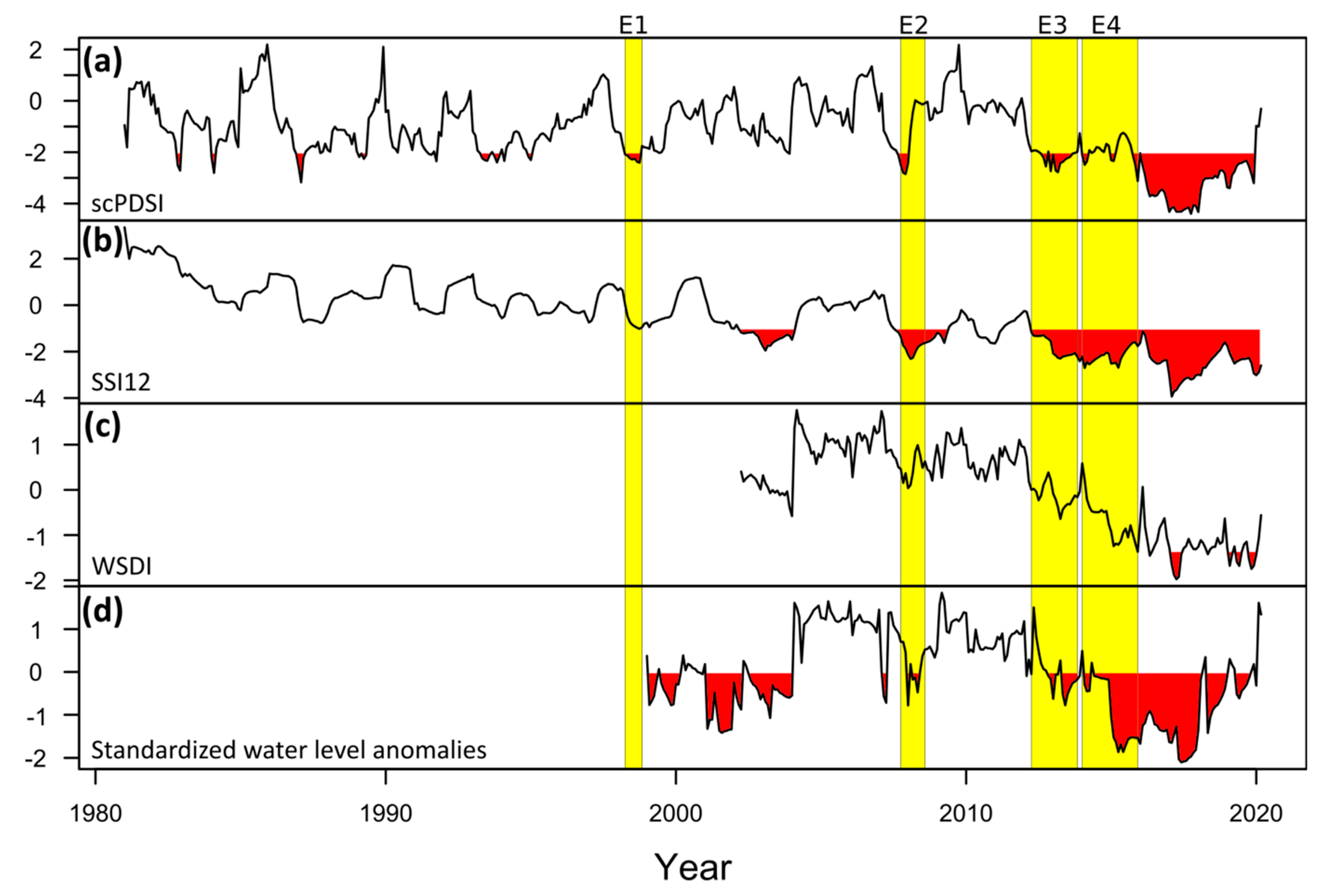
| Drought Index | Product/Data Name | Time Period | Temporal Resolution | Spatial Resolution | Data Source | Accessed on |
|---|---|---|---|---|---|---|
| SPEI | P | 01/1980 to 12/2015 | Monthly | 0.25° | https://bit.ly/2QyPvbm | 15 Jan 2021 |
| PET | 01/1980 to 12/2015 | Monthly | 0.25° | https://bit.ly/2QyPvbm | 15 Jan 2021 | |
| SWDIS | SMOS L3 SSM (asc) | 06/2010 to 03/2020 | Monthly | 0.225° | http://bec.icm.csic.es | 10 Feb 2021 |
| SMOS L3 SSM (des) | 06/2010 to 03/2020 | Monthly | 0.225° | http://bec.icm.csic.es | 10 Feb 2021 | |
| scPDSI | CRU TS-based P | 01/1981 to 12/2020 | Monthly | 0.5° | https://bit.ly/3v8sUl1 | 10 Jun 2021 |
| CRU TS-based T | 01/1981 to 12/2020 | Monthly | 0.5° | https://bit.ly/3v8sUl1 | 10 Jun 2021 | |
| SSI | Streamflow | 01/1980 to 03/2020 | Daily | --- | https://bit.ly/3vb2LSn | 10 Jun 2021 |
| WSDI and GGDI | GRACE-based CSR v2.0 | 04/2002 to 03/2020 | Monthly | 0.25° | https://bit.ly/3bOqNeg | 04 Aug 2021 |
| GRACE-based GFZ v3 | 04/2002 to 03/2020 | Monthly | 1° | https://bit.ly/2Sm2ldE | 04 Aug 2021 | |
| GRACE-based JPL v2 | 04/2002 to 03/2020 | Monthly | 0.5° | https://grace.jpl.nasa.gov | 04 Aug 2021 | |
| GGDI | GLDAS Noah Model | 04/2002 to 03/2020 | Monthly | 0.25° | https://disc.gsfc.nasa.gov | 04 Aug 2021 |
| TerraClimate | 04/2002 to 03/2020 | Monthly | 1/24° | https://bit.ly/3c550iL | 04 Aug 2021 |
| Drought Category | SPEI/SSI | Probability [%] 1 | SWDISa | scPDSI | WSDI | GGDI |
|---|---|---|---|---|---|---|
| Extreme wet | >2.00 | 84.14 | >0.44 | >4.00 | >0.96 | >0.62 |
| Severe wet | 1.50 to 1.99 | 81.86 | 0.34 to 0.44 | 4.00 to 3.00 | 0.84 to 0.96 | 0.52 to 0.62 |
| Moderate wet | 1.00 to 1.49 | 77.45 | 0.23 to 0.33 | 2.99 to 2.00 | 0.64 to 0.83 | 0.33 to 0.51 |
| Near normal | 0.99 to −0.99 | 68.27 | 0.24 to −0.82 | 1.99 to −1.99 | 0.63 to −1.30 | 0.32 to −1.08 |
| Moderate dry | −1.00 to −1.49 | 9.18 | −0.83 to −1.15 | −2.00 to −2.99 | −1.31 to −1.49 | −1.09 to −1.34 |
| Severe dry | −1.50 to −1.99 | 4.41 | −1.16 to −1.27 | −3.00 to −3.99 | −1.50 to −1.67 | −1.35 to −1.49 |
| Extreme dry | <−2.00 | 2.28 | <−1.28 | <−4.00 | <−1.68 | <−1.50 |
| Time Scale [Months] | Event | Start [Date] | End [Date] | Duration [Months] | Average SPEI [-] 1 | Dry Area Peak [%] 2 | Severity [-] |
|---|---|---|---|---|---|---|---|
| SPEI3 | E1 | April-98 | October-98 | 7 | −1.69 | 90.58 | 11.82 |
| E2 | May-07 | January-08 | 9 | −1.73 | 80.09 | 15.61 | |
| E3 | March-12 | October-12 | 8 | −1.78 | 94.67 | 14.27 | |
| E4 | August-15 | December-15 | 5 | −1.75 | 95.99 | 8.76 | |
| SPEI12 | E1 | April-98 | November-98 | 8 | −1.76 | 90.69 | 14.06 |
| E2 | October-07 | August-08 | 11 | −1.73 | 87.16 | 19.00 | |
| E3 | April-12 | November-13 | 20 | −1.83 | 92.93 | 36.55 | |
| E4 | January-14 | December-15 | 21 | −1.86 | 91.86 | 44.63 |
| Type of Drought | Drought Index | Site | Common Time Period | SPEI3 [-] | SPEI12 [-] |
|---|---|---|---|---|---|
| Agricultural | SWDISa [-] | - | Jun 2010 to December 2015 | 0.665 * | 0.388 * |
| scPDSI [-] | - | Jan 1981 to December 2015 | 0.680 * | 0.700 * | |
| Hydrological | SSI3 | Propriá | Mar/Dec 1980 to December 2015 | 0.028 | 0.362 * |
| SSI12 | Propriá | Dec 1980 to December 2015 | −0.026 | 0.221 * | |
| WSDI | - | Apr 2002 to December 2015 | 0.555 * | 0.772 * | |
| GGDI | - | May 2002 to December 2015 | −0.036 | −0.007 |
Publisher’s Note: MDPI stays neutral with regard to jurisdictional claims in published maps and institutional affiliations. |
© 2021 by the authors. Licensee MDPI, Basel, Switzerland. This article is an open access article distributed under the terms and conditions of the Creative Commons Attribution (CC BY) license (https://creativecommons.org/licenses/by/4.0/).
Share and Cite
Paredes-Trejo, F.; Barbosa, H.A.; Giovannettone, J.; Kumar, T.V.L.; Thakur, M.K.; Buriti, C.d.O.; Uzcátegui-Briceño, C. Drought Assessment in the São Francisco River Basin Using Satellite-Based and Ground-Based Indices. Remote Sens. 2021, 13, 3921. https://doi.org/10.3390/rs13193921
Paredes-Trejo F, Barbosa HA, Giovannettone J, Kumar TVL, Thakur MK, Buriti CdO, Uzcátegui-Briceño C. Drought Assessment in the São Francisco River Basin Using Satellite-Based and Ground-Based Indices. Remote Sensing. 2021; 13(19):3921. https://doi.org/10.3390/rs13193921
Chicago/Turabian StyleParedes-Trejo, Franklin, Humberto Alves Barbosa, Jason Giovannettone, T. V. Lakshmi Kumar, Manoj Kumar Thakur, Catarina de Oliveira Buriti, and Carlos Uzcátegui-Briceño. 2021. "Drought Assessment in the São Francisco River Basin Using Satellite-Based and Ground-Based Indices" Remote Sensing 13, no. 19: 3921. https://doi.org/10.3390/rs13193921









